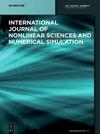磁混合Cu - Al2O3/水纳米流体在具有吸力的可渗透拉伸片上流动的数值研究
IF 1.4
4区 工程技术
Q2 ENGINEERING, MULTIDISCIPLINARY
International Journal of Nonlinear Sciences and Numerical Simulation
Pub Date : 2016-08-01
DOI:10.1515/ijnsns-2016-0037
引用次数: 435
摘要
本文介绍了混合纳米流体的概念及其热物理性质的新改进模型。混合纳米流体是一种先进的传统传热流体,已被用于提高传热速率。采用混合纳米流体(Cu−Al2O3/water)$({\rm{Cu - A}}{\rm{l}}_{\rm{2}}}{\rm{O}}_{\rm{/ {3}}}{\rm{/water}})$和纳米流体(Cu/water)两种不同的流体,研究了磁场作用下可渗透拉伸片上流动和传热现象的参数特征。分析了各种物理参数和对感兴趣物理量的影响。在磁场环境下,纳米流体(Cu−Al2O3/water)$({\rm{Cu - A}}{\rm{l}}_{\rm{2}}}{\rm{O}}_{\rm{/ {3}}}{\rm{/water}})$的传热速率高于纳米流体(Cu/water) $。可以尝试不同纳米复合材料的更多组合,以达到期望的传热率。本文章由计算机程序翻译,如有差异,请以英文原文为准。
Numerical Investigation of Hydromagnetic Hybrid Cu – Al2O3/Water Nanofluid Flow over a Permeable Stretching Sheet with Suction
Abstract An emerging concept of hybrid nanofluid with a new improved model of its thermophysical properties are introduced in the present work. Hybrid nanofluid is an advanced type of conventional heat transfer fluids, which has been employed for the enhancement of heat transfer rate. Two distinct fluids, namely hybrid nanofluid (Cu−Al2O3/water)$({\rm{Cu - A}}{{\rm{l}}_{\rm{2}}}{{\rm{O}}_{\rm{3}}}{\rm{/water}})$ and nanofluid (Cu/water) are used to investigate the parametric features of the flow and heat transfer phenomena over a permeable stretching sheet in the presence of magnetic field. The effects of various physical parameters and effecting physical quantities of interest are analyzed. From this study it is observed that the heat transfer rate of hybrid nanofluid (Cu−Al2O3/water)$({\rm{Cu - A}}{{\rm{l}}_{\rm{2}}}{{\rm{O}}_{\rm{3}}}{\rm{/water}})$ is higher than that of Nanofluid (Cu/water) under magnetic field environment. More combinations of different nanocomposites can be tried so that the desired heat transfer rate can be achieved.
求助全文
通过发布文献求助,成功后即可免费获取论文全文。
去求助
来源期刊
CiteScore
2.80
自引率
6.70%
发文量
117
审稿时长
13.7 months
期刊介绍:
The International Journal of Nonlinear Sciences and Numerical Simulation publishes original papers on all subjects relevant to nonlinear sciences and numerical simulation. The journal is directed at Researchers in Nonlinear Sciences, Engineers, and Computational Scientists, Economists, and others, who either study the nature of nonlinear problems or conduct numerical simulations of nonlinear problems.

 求助内容:
求助内容: 应助结果提醒方式:
应助结果提醒方式:


